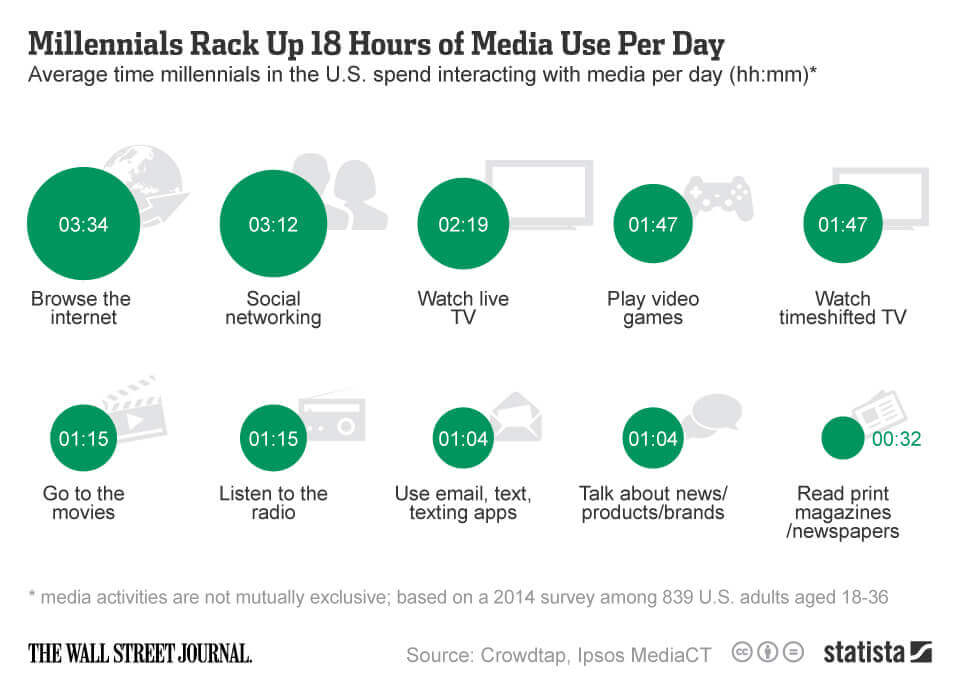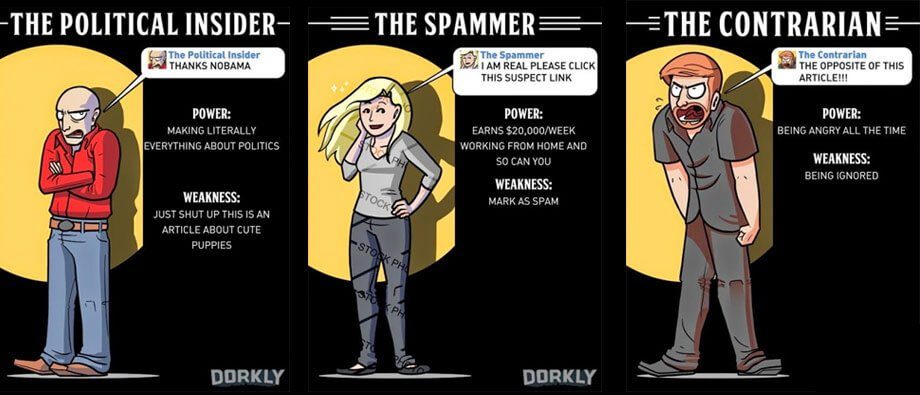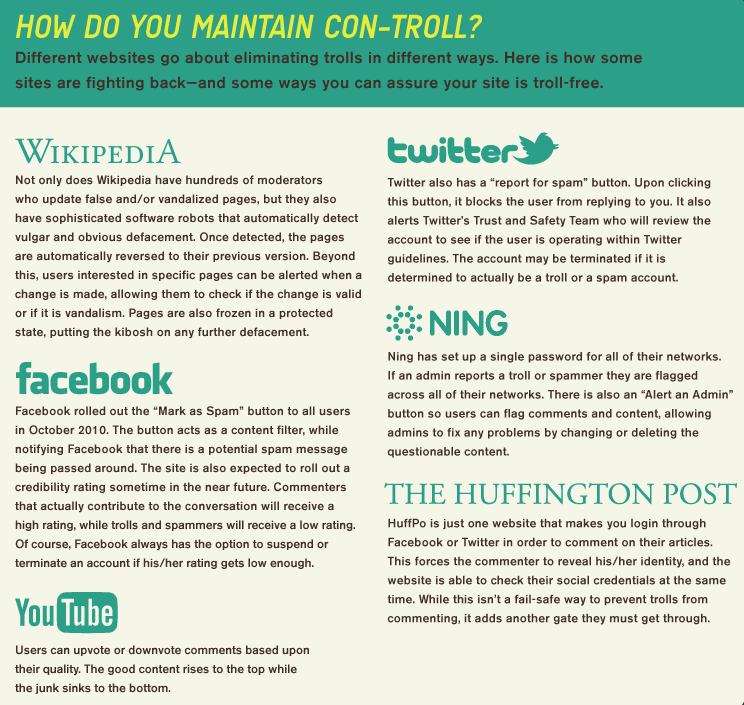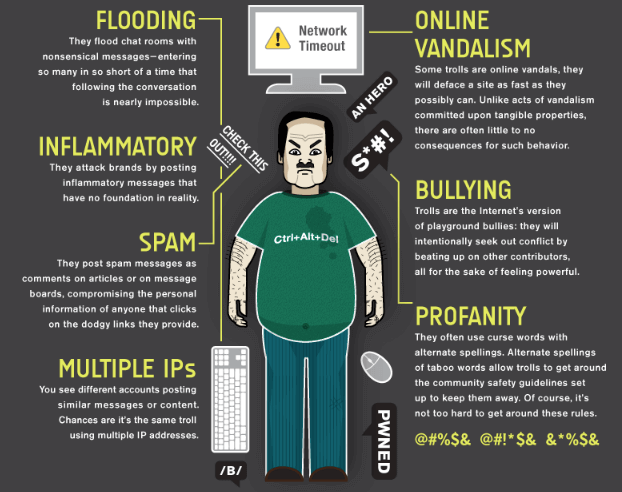If you use social media, you’ve probably heard, or will hear, about a group of users called “trolls.” These individuals thrive on attention and can incite hatred and provoke anger across various online platforms. They are at their happiest when they successfully lure other users into unproductive, time-consuming discussions and debates.
Trolls will try to tarnish your online experience, but you don’t have to let them succeed. You can effectively deal with these troublemakers to keep your online life safe and fun. Below, you’ll learn about common types of trolls and how you can identify them. You’ll also learn a tried-and-true technique that can help you mitigate the potentially damaging effects associated with online trolls.
1) Defining the Internet Troll
The word troll is slang for an individual that aims to provoke others online. They often use offensive and provocative statements to start conversations. Whenever these people post content designed to elicit an emotional response from readers, it’s called “trolling.”
Interestingly enough, many trolls do not believe the things they write. The internet is a great place for people to share their opinions, but this isn’t the goal among these online hooligans. This group posts content to stir the pot. At the end of the day, they simply want to start a big conversation that leads nowhere and distracts readers from the original content.
2) Their Similarities
The online world allows people to stay pretty anonymous, which makes it hard to determine the similarities between this group of internet users. According to an online survey, 28 percent of Americans say they participate in “malicious online activity directed at somebody they don’t know.” An additional 23 percent reported that they have “maliciously argued over an opinion with a stranger” online. Overall, millennial men are the most likely group to engage in internet trolling.
At this point, it’s important to mention that not all angry social media users are trolls. Remember, these people don’t always believe what they’re saying. On the other hand, spirited, angry posters do believe in the information they disseminate on social media.
3) Are They Dangerous?
The internet can be a scary place. Industry experts recommend that every computer owner invests in fraud prevention and data backup services to stay safe online. That being said, do trolls steal things from their victims? Do they threaten your online security?
Generally, the answer is no. Most of these people simply find arguing to be funny- even though they often take things too far . There are a few online trolls that post spam messages, though. In the event you click on one of these links, your personal information will be at risk. To protect yourself, avoid clicking on comments that include links. They won’t all be harmful, but avoiding them altogether will help ensure that you keep your private information protected.
4) How They Attack
Trolls don’t really discriminate when it comes to creating waves online. They will use any tactic they can to derail conversations and distract readers. However, trolls can generally be recognized by archetype-the first of which is the grammar corrector. These people try to discredit online messages by highlighting their spelling mistakes and grammar errors. Another archetype many trolls identify with is a bully. These people leave comments and post messages that are rude and/or mean. They insult people in hopes that they can make others’ ideas seem small and meaningless.
The off-topic troll adds irrelevant information to various topics on social media. They want to make other users talk about the random thing that they’ve posted, not the original content. Most recently, some online troublemakers have become known as political trolls. 2016 was even named the year of the political troll by The New Yorker.
5) Times and Platforms
Internet trolls are active at all times of the day. However, the meanest comments are made by users on their computers at three in the morning. Nine in the evening is another time these individuals are often active online.
People that like to tease others on the internet do so on a variety of platforms. One site many users access that’s full of trolls is YouTube. If you spend a few minutes viewing the comments on popular videos, you’ll see a trolling comment or two. You will also run into this group of people on Facebook, Pinterest and Twitter. Essentially, the internet troll will operate on any site or platform where they can incite anger in other users.
6) Identifying a Troll
When you’re trying to determine if someone is an online prankster, there are a few signs you can look for. First, see if they have made more than one comment. These individuals often practice “flooding,” which means they post numerous messages at a time. People that post multiple messages that don’t further a conversation are probably trolling.
Comments that make fun of topics or users likely belong to an internet troll, too. In some ways, these people are the bullies of the web. Comments that seek out conflict are probably crafted by one of these online bullying types.
Individuals that use a lot of profanity or capital words might also be pranksters. This group of people often work around profanity blockers on sites by using symbols to complete curse words. Comments that include a lot of profanity and misspelled words can be reasonably attributed to a troll.
7) Response Techniques
From time to time, you might find yourself responding to an online troll. If this ever happens to you, there are a few techniques you can use to improve your likelihood of success. One of the best ways to take power away from these people is to use humor tactfully. Without agreeing with their comment or idea, turn their content into something humorous that will defuse the situation.
Here’s a good example from Southwest Airlines. Earlier this year, a woman named Paige decided to troll Southwest Airlines. She contacted Linnea, one of Southwest’s online representatives, and told her that she had a negative experience with a rude flight attendant on her last trip. Long story short, the Southwest representative asked for a confirmation number and the name of the flight attendant. The troll responded with a photo of Brittney Spears in a flight attendant costume.
Within a few minutes, the representative typed back “Opps, she did it again.” In five simple words, she was able to take power away from the troll and regain control of the situation.
In the event you can’t counter someone’s post with humor, see if you can disprove it with a fact. Online troublemakers often spread rumors and false information because they want to provoke a big reaction. When the iPhone six was released, a rumor that it would bend out of shape in your pocket circulated. The internet even created a hashtag for the event, #bendgate.
Apple responded to this issue head-on and told its customers that the iPhone would not bend with normal use. They were able to stop rumors by simply addressing them with a fact.
8) The Best Solution
There’s a popular saying among tech-savvy internet users, “don’t feed the trolls.” If you ignore these people, you will take away the satisfaction they would otherwise receive from a reply. Don’t get angry, don’t write back, just let their comment lay stagnant. As long as the comment isn’t totally egregious, it’s best to let it be. Otherwise, they might try to berate you for removing their content.
Sometimes, Trolling Is Clever and Funny
Most of the time, trolling is more annoying than it is funny. However, from time to time, a comment will be posted that’s widely enjoyed by all. For example, KitKat decided to join the trolling community that attacked the iPhone six in a clever and humorous way.
Oreo trolled the National Football League when the power went out during Super Bowl XLVII. The company released a photo that read “You can still dunk in the dark.” The image was shared more than 10,000 times in one hour on Twitter.
Conclusion
Now that you are aware of trolls and their online looks and behaviors, you will start to recognize them on a plethora of websites. Their rude, off-topic and anger-inducing comments might be designed to ruin your day, but they don’t have to.
One option is to try and counter their malicious writing with humor or truth. That being said, it’s generally much easier to ignore them. These people live for replies, so the only real way to get rid of them is not to engage with them in the first place.
From time to time, trolls won’t try to make you mad, they will try to make you laugh. Several companies even market themselves with trolling techniques because it’s a clever way to stay relevant in today’s digital world. For the most part, though, you’ll want to avoid trolling altogether to keep your sanity intact.
Identifying and disarming online trolls will take a bit of practice, but it can absolutely be done. As time goes on, you’ll find that you can more readily recognize and avoid time-consuming and annoying interactions with these types of individuals online.
If you feel that are you susceptible to being trolled but also don’t feel comfortable how to identify an internet troll, how to respond and block trolls, then consider having a 24/7 staff that you can speak with and ask any questions you have. Membership with HelpCloud Tech Support allows you access to our experts and help with anything tech, including your experience online.







